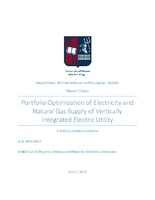Portfolio οptimization of electricity and natural gas supply of vertically integrated electric utility

View/
Abstract
This thesis introduces a Non-Linear Programming (NLP) model that comprises of two separate models/parts. The model is resolved in the General Algebraic Modeling System (GAMS) environment using the IPOPT solver. The first part of the model is a Dynamic Economic Dispatch (DED) model that simulates the day-ahead electricity market calculating the optimal scheduling between energy producers while the second part is an econometric model that calculates the optimal retail electricity and natural gas prices offered to price responsive customers. The integrated model is applied in a vertically integrated company operating a gas-fired power plant. Three different CO2 emission prices are examined in the first part of the model in order to calculate their impact on the company’s profits from its wholesale activities. Also, in the second part of the model three different scenarios are examined calculating the impact that various levels of i) energy (electricity and gas) demand and ii) customers’ demand elasticity, have on the company’s financial performance. The integrated model is designed to calculate the optimal retail prices offered by the company to its customers in order to maximize the company’s profits. Also, the model determines the optimal power scheduling between day-ahead and spot markets. First results indicate that energy prices offered to customers are constant during the 24-hour period. These constant values are calculated by the retailer in order to maximize its profits when implementing retail prices at their maximum allowed level. Results also highlight the important link between CO2 prices and the company’s profitability. The company’s total profits are €17.3 m on average for a range of possible scenarios while its revenues and costs are €143.4 m and €126.2 m respectively. This integrated model constitutes a pivotal study and a tool for companies operating in both wholesale and retail electricity and natural gas sectors. Further research on customers’ behavior would provide useful information and inputs to expand this model and implement bundle pricing and other strategies to attract customers and maximize profits.


